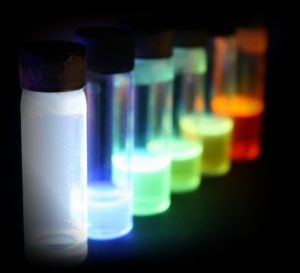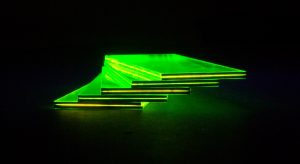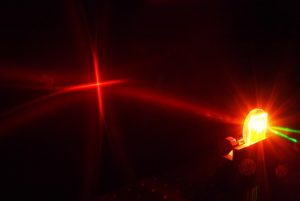 Organic semiconductors are materials that combine useful properties of plastics (easy shaping, flexibility, low weight, low-cost processing) with the possibility of conducting electricity and emitting light. At the University of St Andrews, which lies since 1413 in a beautiful seaside location in Scotland (UK), Prof. Ifor Samuel converts his fascination for organic semiconductors into new materials, devices and applications.
Organic semiconductors are materials that combine useful properties of plastics (easy shaping, flexibility, low weight, low-cost processing) with the possibility of conducting electricity and emitting light. At the University of St Andrews, which lies since 1413 in a beautiful seaside location in Scotland (UK), Prof. Ifor Samuel converts his fascination for organic semiconductors into new materials, devices and applications.
Ifor Samuel received his MA and PhD diplomas from the University of Cambridge (England, UK), after working on optical spectroscopy of organic semiconductors. After his PhD, Samuel moved to Paris for two years to perform postdoctoral work at CNET-France Telecom, investigating the non-linear optical properties of organic materials. Back to England, he carried out research at Cambridge for a year, as research fellow at Christ’s College. After that, he set his own research group on light-emitting polymers at the University of Durham where he also held a Royal Society University Research Fellowship. In 2000 he joined the University of St Andrews, where he founded, in 2001, the Organic Semiconductor Centre, dedicated to interdisciplinary research on understanding and improving organic semiconductors and exploring their applications in the semiconductor, electronics and optoelectronics industries. In 2004 he founded the company Ambicare Health Ltd that produces wearable light sources for healthcare applications.
Ifor Samuel holds an H-index of 58. He has published more than 400 journal papers. His publications have more than 12,000 citations. He is a Fellow of the Royal Society of Edinburgh, the Institute of Physics, the International Society for Optics and Photonics (SPIE) and the Royal Society of Chemistry. Among other prizes, he won the Chemical Dynamics Award for 2016 of the Royal Society of Chemistry for his contributions to understanding light emission and fundamental photophysical processes in organic semiconductors.
At the University of St Andrews, Ifor Samuel is Professor of Physics, Director of the Organic Semiconductor Centre and head of the Organic Semiconductor Optoelectronics group. He is a member of the editorial board of the Journal of Photonics for Energy, and Editor-in-Chief of Synthetic Metals, a journal of electronic polymers and electronic molecular metals.
Here follows a short interview with Professor Ifor Samuel, who will be in Campinas (Brazil) at the end of September to talk about Organic Semiconductor Optoelectronics in a plenary lecture of the XV Brazil-MRS Meeting.
SBPMat newsletter: – In your opinion, what are your most significant scientific contributions to the organic semiconductors field? Explain them very briefly and, if possible, share references of resulting publications.

Ifor Samuel: – There have been two main themes to my research. One is understanding organic semiconductors with the aim of using that understanding to improve them. In this direction, I have studied the light emission process in conjugated polymers which is very important for organic light-emitting diodes (OLEDs) [1,2], developed as a new class of OLED material (with P.L. Burn) [3], and measured exciton diffusion which is very important in polymer solar cells [4].
The other major theme has been pushing the boundaries of devices and applications. Here, instead of developing new materials, I have been exploring what new things can be done with existing materials. For example, whilst nearly everybody was working on OLEDs for displays, I had a very interesting discussion with James Ferguson, head of dermatology at Ninewells Hospital in Dundee, leading to the development of wearable light sources for treatment of non-melanoma skin cancer [5]. More recently my team developed a wearable organic optoelectronic sensor for muscle contraction [6]. We have also been working with the Belgian Royal Military Academy on using conjugated polymer fluorescence and lasing for explosive detection for humanitarian demining. Recently we demonstrated (as part of a large project with collaborators in Edinburgh, Strathclyde and Oxford) the use of organic semiconductors for visible light communication, achieving record data rates for white visible light communication [7].
- Measurement of Absolute Photoluminescence Quantum Efficiencies in Conjugated Polymers. N.C. Greenham, I.D.W. Samuel, G.R. Hayes, R.T. Phillips, Y.A.R.R. Kessener, S.C. Moratti, and A.B. Holmes. Chem. Phys. Lett. 241, 89 (1995).
-

Fluorescent receiver for visible light communications. Efficient interchain photoluminescence in a high-electron-affinity conjugated polymer. I.D.W. Samuel, G. Rumbles and C.J. Collison. Physical Review B. 52, 11573 (1995).
- A green phosphorescent dendrimer for light-emitting diodes. S.C. Lo, N.A.H. Male, J.P.J. Markham, S.W. Magennis, P.L. Burn, O.V. Salata and I.D.W. Samuel. Adv. Mater. 14, 975 (2002).
- Determining the optimum morphology in high-performance polymer-fullerene organic photovoltaic cells. G.J. Hedley, A.J. Ward, A. Alekseev, C.T. Howells, E.R. Martins, L.A. Serrano, G. Cooke, A. Ruseckas and I.D.W. Samuel. Nature Comm. 4, 2867 (2013).
- An open pilot study of ambulatory photodynamic therapy using a wearable low-irradiance organic light-emitting diode light source in the treatment of nonmelanoma skin cancer. S.K. Attili, A. Lesar, A. McNeill, M. Camacho-Lopez, H. Moseley, S. Ibbotson, I.D.W. Samuel and J. Ferguson. Brit. J. Derm. 161, 170 (2009).
-

Conjugated polymer laser. Wearable organic optoelectronic sensors for medicine. A.K. Bansal, S.B. Hou, O. Kulyk, E.M. Bowman and I.D.W. Samuel. Adv. Mater. 27, 7638 (2015).
- Visible light communication using a blue GaN µLED and fluorescent polymer color converter. Chun, P.P. Manousiadis, S. Rajbhandari, D.A. Vithanage, G. Faulkner, D. Tsonev, J.J.D. McKendry, S. Videv, E.Y. Xie, E.D. Gu, M.D. Dawson, H. Haas, G.A. Turnbull, I.D.W. Samuel and D.C. O’Brien. IEEE Photonics Technology Letters 26, 2035 (2014).
SBPMat newsletter: – You have authored many patents. Are there products in the market based on our inventions?
Ifor Samuel: – The majority of my patents are licensed to companies that are developing them. There are several patents relating to light-emitting dendrimers as highly efficient solution-processed OLED materials. These were initially licensed to Opsys Ltd in Oxford, who were later acquired by Cambridge Display Technology, who in turn are now wholly owned by Sumitomo Chemical and incorporate aspects of the technology in their products. For the skin cancer treatment, the patents were licensed to the spin-out company Ambicare Health Ltd. Ambicare have brought two related products to market – one is a wearable red light source for skin cancer treatment, and the other is a wearable blue light source for acne treatment.
SBPMat newsletter: – The properties of organic semiconductors are different from those of inorganic semiconductors, leading to creation of novel devices. Could you give some examples of existing and not-yet invented devices based on organic semiconductors?
Ifor Samuel: – The advantages of organic semiconductors come from how they combine novel semiconducting optoelectronic properties with simple fabrication and the scope to tune properties by changing their structure. An existing organic semiconductor device is an OLED mobile phone display or television. They give very vivid images, together with outstanding contrast and viewing angle. However, in contrast to inorganic semiconductors which are rigid and brittle, organic semiconductors can be used to make flexible devices – such as light-emitting bandages for medicine. The flexibility has not yet been fully exploited, but also simplifies manufacture which could be by simple roll to roll processes. This would be an excellent way to make solar cells in Brazil. The laser explosive sensors are completely different from inorganic lasers because the explosive vapour binds to the gain medium and modifies its light emission.
SBPMat newsletter: – If you desire, leave an invitation for our readers to go to your plenary lecture at the XV Brazil-MRS Meeting.
Ifor Samuel: – I have really enjoyed my previous visits to the Brazil MRS meeting and look forward to visiting Campinas. Do come to my lecture to hear about the remarkable world of organic semiconductors and their applications.
Link to the abstract of Ifor Samuel´s plenary lecture at the XV Brazil-MRS Meeting: http://sbpmat.org.br/15encontro/speakers/abstracts/6.pdf
